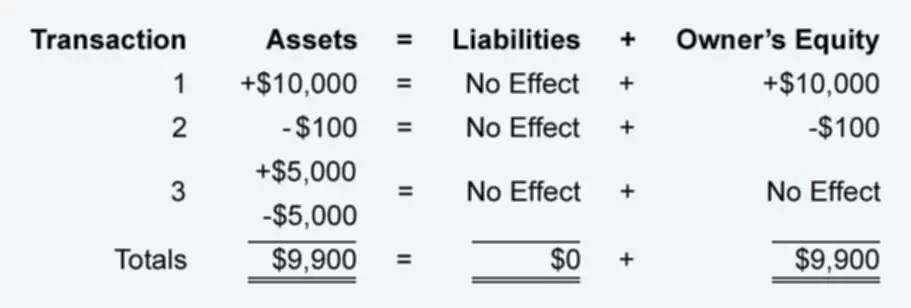Content

Taking the balance at the beginning of the month, adding the deposits, and subtracting the withdraws would result in the balance at the end of the month. Free AccessFinancial Metrics ProKnow for certain you are using the right metrics in the right way. Learn the best ways to calculate, report, and explain NPV, ROI, IRR, Working Capital, Gross Margin, EPS, and 150+ more cash flow metrics and business ratios. But while the first scenario is a cause for concern, a negative balance could also result from an aggressive dividend payout – e.g. dividend recapitalization in LBOs. Next, another important consideration is the dividend policy of the company. With that said, a high-growth company with minimal free cash flow will conversely re-invest toward extending its growth trajectory (e.g. research & development, capital expenditures). FREE INVESTMENT BANKING COURSELearn the foundation of Investment banking, financial modeling, valuations and more.
- The Statement of retained earnings is the shortest of the four primary financial accounting statements, but it provides the clearest illustration of the interrelated nature of these statements.
- You can also choose to submit it as part of your business plan during loan/funding application.
- Therefore, the retained earnings value on the balance sheet is a running total of additional gains minus dividends.
- Let’s say ABC Company has a beginning retained earnings of $200,000.
- It starts with retained earnings at the beginning of the period, adds in net income, and subtracts dividends to come up with retained earnings for the current period.
- The first entry on the statement is the previous year’s carried-over balance.
The retention ratio is the amount of profit kept by the business for future projects. The payout ratio is the opposite – the amount paid out to shareholders. When firms are undergoing rapid growth and expansion, by contrast, they typically bypass dividend payment entirely and direct all income into retained earnings. Retained Earnings measures the total accumulated profits kept by the company to date since inception, which were not issued as dividends to shareholders.
Is retained earnings a debit or a credit?
The retention ratio helps investors determine how much money a company is keeping to reinvest in the company’s operation. If a company pays all of its retained earnings out as dividends or does not reinvest back into the business, earnings growth might suffer.
- This statement breaks down cashflows into operating, investing, and financing activities.
- Retained earnings specifically apply to corporations because this business structure is set up to have shareholders.
- Others might split the gains, or distribute the surplus to investors.
- This entry can be taken from the previous year’s balance sheet or the ending balance of the previous year’s retained earnings.
If you have investors to whom you pay dividends, you would subtract the amount of dividends paid in this step. If you own a very small business or are a sole proprietor, you can skip this step.
Step 1: Find the prior year’s ending retained earnings balance
The beginning equity balance is always listed on its own line followed by any adjustments that are made to retained earnings for prior period errors. These adjustments could be caused by improper accounting methods used, poor estimates, or even fraud. Any time you’re looking to attract additional investors or apply for a loan, it’s helpful to have a statement of retained earnings prepared. In this article, we’ll provide the retained earnings formula and explain how to prepare a statement of retained earnings.
- Many or all of the products here are from our partners that pay us a commission.
- Send invoices, get paid, track expenses, pay your team, and balance your books with our free financial management software.
- To calculate RE, the beginning RE balance is added to the net income or reduced by a net loss and then dividend payouts are subtracted.
- Retained earnings are the profits or net income that a company chooses to keep rather than distribute it to the shareholders.
- The statement of retained earnings is afinancial statement that is prepared to reconcile the beginning and ending retained earnings balances.
Because profits belong to the owners, retained earnings increase the amount of equity the owners have in the business. Is part of a company’s financial statement, which explains any change in retained earnings during an accounting period. Note incidentally, that a few firms sometimes declare dividend totals that exceed the firm’s reported net earnings.
Step 3: Subtract any dividends paid to your investors
It uses crucial insights like net income recorded in other financial statements for doing the reconciliation of data. The statement of retained earnings follows GAAP, commonly known as generally accepted accounting principles. The statement of retained earnings has other names such as the statement of owners equity, https://www.bookstime.com/ statement of shareholders equity, or an equity statement. Net income that isn’t distributed to shareholders becomes retained earnings. Net income is the money a company makes that exceeds the costs of doing business during the accounting period. The net income calculation shows up on the company’s income statement.

The revenue number is important if you’re wondering how to measure your company’s financial performance, but it’s only one data point. Retained earnings tell shareholders how much their shares retained earnings statement are worth. Other metrics, like EBITDA and net revenue, show how efficiently the company is operating. There are several good reasons why financial reporting is done with multiple documents.
When a certain amount of net income is not paid out to shareholders or reinvested back into the business, it becomes retained earnings. Mind that some companies choose to keep money in retained earnings accounts for years, so the total figure you see on some statements is a result of many years of hard work savings. This financial statement proves the organization’s ability to generate revenue, reduce costs or do both. It includes information on all the profit the company has secured.

Although this statement is not included in the four main general-purpose financial statements, it is considered important to outside users for evaluating changes in the RE account. This statement is often used to prepare before the statement of stockholder’s equity because retained earnings is needed for the overall ending equity calculation.
However, many businesses choose to add it at the bottom of another financial statement e.g. the balance sheet or a merged statement of income and retained earnings. You can also choose to submit it as part of your business plan during loan/funding application. The statement is designed to highlight how much a company took in from sales, the cost of goods/services sold and other expenses. In short, retained earnings represent the profit/income the business has generated but did not pay out as dividends. Your retained earnings balance will always increase any time you have positive net income, and it will decrease if your business has a net loss. Retained earnings can be used to purchase additional assets, pay down current liabilities, or they be held for possible future distribution. After subtracting the amount of dividends, you’ll arrive at the ending retained earnings balance for this accounting period.
This entry can be taken from the previous year’s balance sheet or the ending balance of the previous year’s retained earnings. Paul’s net income at the end of the year increases the RE account while his dividends decrease the overall the earnings that are kept in the business. At the end of 2019, John’s Bicycle Shop had retained earnings in the amount of $90,000, which can be used to invest back into the business, such as by purchasing a larger storefront. The money can also be distributed to John, his brother, and his sister as a dividend, or some combination of the two options. However, if you have one or two investors in your business, you’ll want to list the amount of money distributed to them during this period. There are businesses with more complex balance sheets that include more line items and numbers.